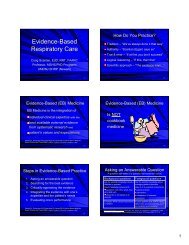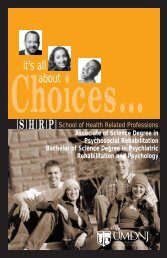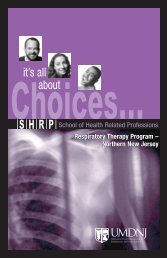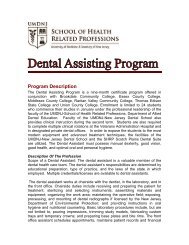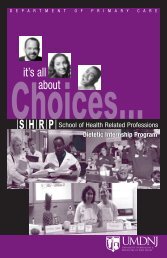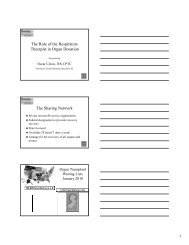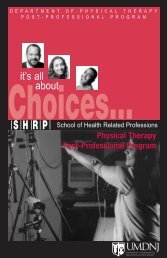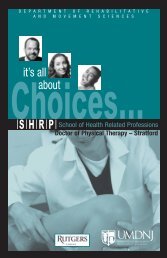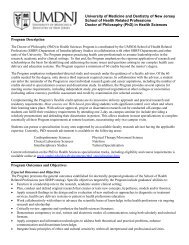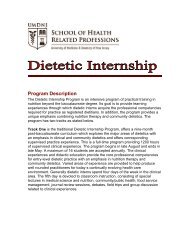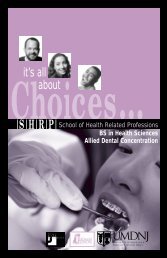JACK et al.: VIRTUAL REALITY-ENHANCED STROKE REHABILITATION 315Fig. 12. Clinical study results for all patients. (A) Thumb range of movement. (B) Thumb angular velocity. (C) Index finger fractionation. (D) Thumb averagesession mechanical work.to be reduced significantly to counter fatigue. Moving to fourfingers and thumb exercises removed this difficulty.IV. DISCUSSION OF STUDY RESULTSThe great advantage for the therapist of using VR-based exercisesis the wealth of objective measures of a patient’s performance.Thus, the present study’s experimental data consist ofobjective measures, as well as subjective patient’s evaluations.Fig. 12(A) represents the change in thumb range of motionfor the three patients over the duration of the study. Data areaveraged across sessions within each day’s training. Calculationof improvements or decrements is based on the regressioncurves fit to the data. It can be seen that there is improvement inall three subjects, ranging from 16% in subject LE, who had theleast range deficit, to 69% in subject DK, who started with a verylow range of thumb motion of 38 . Fig. 12(B) shows that thethumb angular speed remained unchanged (an increase of 3%)for subject LE and improved for the other two subjects by 55%and 80%, patient DK again showing the largest improvement.Fig. 12(C) presents the change in finger fractionation, i.e., thepatients’ ability for individuated finger control. For patients MLand DK, this variable showed improvement of 11% and 43%, respectively.Subject LE showed a decrease of 22% over the ninedays. Finally, Fig. 12(D) shows the change in the average session’smechanical work of the thumb for the nine <strong>rehabilitation</strong>sessions. The three patients improved their daily thumb mechanicalwork capacity by 9–25%.The data shown in Fig. 12 are, by necessity, limited, becausesimilar measures were taken for the fingers as well. Full datasets have been submitted for publication in a companion clinicalpaper [27]. The data seem to indicate positive changes atthe level of physical hand parameters over this limited clinicalstudy.Fig. 13. Dynamometer readings for the three subjects before, during and at theend of trials for left (“good”) and right (affected) hands.Of all the VR exercises, the only one that required forceexertion was the piston-pushing exercise using the RMII glove.None of the noncomputer exercises required force exertionabove the minimum required to grasp a pen or a paper clip.Thus, if hand-grasping force improved, it was probably due toVR-based therapy. Fig. 13 shows the patients’ grasping forcesmeasured with a standard dynamometer at the start, midwayand at the end of therapy, for both the “good” (left) and affected(right) hands. It can be seen that all three patients improved theirgrasping force for the right hand, this improvement varyingfrom 13% for the strongest patient to 59% for the other two.This correlates somewhat with the 9–25% increase in thumb
316 IEEE TRANSACTIONS ON NEURAL SYSTEMS AND REHABILITATION ENGINEERING, VOL. 9, NO. 3, SEPTEMBER 2001Fig. 14.Daily thumb mechanical work during VR exercises.average session mechanical work ability shown in Fig. 12(D)for two of the patients. Patient LE had no improvement in his“good” hand, but did show 59% improvement in his right-handgrasping force. This improvement may be due to VR therapy.However, two of the patients had an improvement in theleft-hand grasping force as well. In particular, patient DK has aremarkably similar pattern in the change in grasping force forboth hands. This is suggestive of other factors influencing theirgrasping force capacity, such as self-motivation, confidence,and fatigue.If patient fatigue occurred, that may be correlated with thedrop in right-hand grasping force shown in Fig. 13 for patientDK between the middle and end of therapy. The total daily mechanicalwork (sum of thumb effort over all sessions in a day) isplotted in Fig. 14. Although the regression curve is positive forall three patients, daily values clearly plateau and then drop forpatient DK.An important question is whether the improvements seen inthe VR-based exercises transfer to changes in activities of dailyliving. The results of the dynamometer testing do suggest an increasedability for force development. This is a necessary componentof functional hand use. Additionally, the subjects showedchanges in the Jebsen test of hand function. This clinical measuretests the time it takes to pick up common household objectsof different sizes, weights, and configurations (e.g., beans,coins, food cans). All three subjects showed positive changeson the Jebsen test scores, with each subject showing improvementin a unique constellation of test items. None of the tasksthat were a part of the Jebsen battery was practiced during thenon-VR training activities. Anecdotally, Fig. 15 shows a patientbuttoning his shirt in the second week of the training period.This subject was unable to do this activity prior to his participationin the study.The changes that we found in the three patients could be dueto either the nature or intensity of the VR training or the natureor intensity of the real-world tasks. Because both were incorporatedinto the two-week training protocol, it is currently notclear whether these improvements were due to the VR-basedexercises, the real world tasks, or the combination of both. Constraint-induced(CI) movement therapy, an intervention that utilizesintensive practice of real-world tasks, has been reportedFig. 15. Subject DK buttoning his shirt. He was not able to perform thistask prior to the VR-<strong>enhanced</strong> <strong>rehabilitation</strong> training. (© Rutgers University.Reprinted by permission.)to improve the amount of use of that extremity [33], [35]. It is,therefore, quite reasonable to assume that both contributed, tosome degree. Subsequent experiments will be designed to investigatethis issue further and distinguish these possibilities. Itis conceivable that virtual <strong>reality</strong>-<strong>enhanced</strong> <strong>rehabilitation</strong> maybe an innovative way of applying CI therapy. This proceduremay be thought of as a particular form of shaping (see [34] fora discussion of shaping procedures).Subjective evaluation data from the patients was also positive.In a follow-up questionnaire, all three patients strongly agreedthat they wished the VR-based tasks had been part of their originalpost<strong>stroke</strong> therapy. All three agreed that their right handmotion improved and they felt that, with practice, it would improvemore. Two of the three patients strongly agreed that theywould be willing to continue undergoing the intensive trainingof this project.V. CONCLUSION AND FUTURE WORKVR technology has the potential to impact traditional <strong>rehabilitation</strong>techniques. A PC-based VR system for rehabilitatinghand function in <strong>stroke</strong> patients was developed. The system exercisesfour parameters of hand movement: range, speed, frac-



